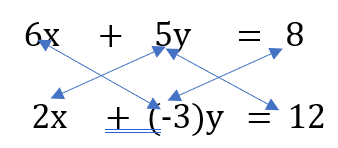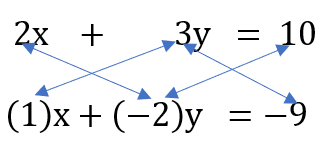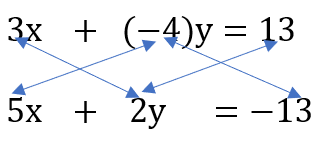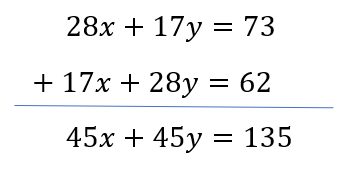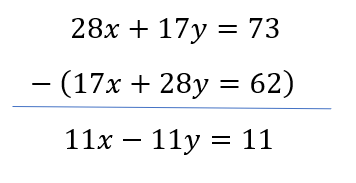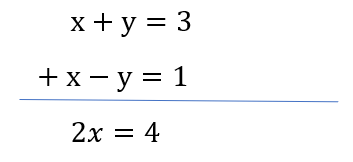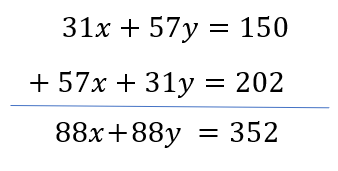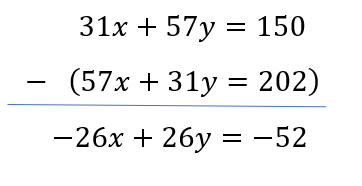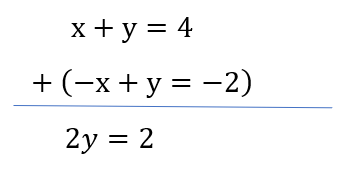1 Ratio and Proportion - Trick #86
N/A
If an amount is to be divided among A, B and C in the ratio l : m : n and the difference between A and B is ‘R’, then
\&space;Part&space;of&space;\(C=\frac{n}{l-m}&space;\times&space;R\),&space;where&space;\(l>&space;m\))
\&space;Total&space;share&space;of&space;\(A,&space;B\)&space;and&space;\(C=\frac{l+m+n}{l-m}&space;\times&space;R\)&space;where&space;\(l>m\))
&space;Difference&space;in&space;share&space;of&space;}&space;B&space;\text&space;{&space;and&space;}&space;C=\frac{m-n}{l-m}&space;\times&space;R,)

2 Ratio and Proportion - Trick #87
N/A
If there are notes of ‘x’ dollars, ‘y’ dollars and ‘z’ dollars in a box in the ratio m:n:r and the total value of notes is ‘R’, then
\&space;Number&space;of&space;notes&space;of&space;\({&space;}^{\prime}&space;x&space;^{\prime}\)&space;dollars&space;\(=\frac{&space;m&space;}{(&space;xm&space;+&space;yn&space;+&space;zr&space;)}&space;\times&space;R\))
\&space;Number&space;of&space;notes&space;of&space;'&space;\(y&space;^{\prime}\)&space;dollars&space;\(=\frac{n}{(x&space;m+y&space;n+z&space;r)}&space;\times&space;R\))
\&space;Number&space;of&space;notes&space;of&space;\({&space;}^{\prime}&space;z&space;^{\prime}\)&space;dollars&space;\(=\frac{r}{(x&space;m+y&space;n+z&space;r)}&space;\times&space;R\))
3 Ratio and Proportion - Trick #88
N/A
If adding/subtracting a certain quantity gives new ratio, then multiplier
&space;}}{\text&space;{&space;Sum&space;of&space;Ratios&space;}})

4 Ratio and Proportion - Trick #89
N/A
If the ratio of alligation of milk and water in a glass is m:n and in other glass alligation is p:q, then the ratio of milk and water in third glass which contains alligation of both glasses is
:\left(\frac{&space;n&space;}{&space;m&space;+&space;n&space;}+\frac{&space;q&space;}{&space;p&space;+&space;q&space;}\right))
5 Ratio and Proportion - Trick #90
N/A
If the ratio of milk and water in the alligation of A litre is p:q then water must be added in it so that ratio of milk and water would be r:s is
}{r(p+q)}&space;\text&space;{&space;litres&space;})
6 Ratio and Proportion - Trick #91
N/A
The ratio of income of two persons A and B is p:q. If the ratio of their expenditures are r:s, then the monthly income of A and B, when each one of them saves ‘R’ dollars will be
}{p&space;s-r&space;q}\))
}{p&space;s-r&space;q}\))
7 Ratio and Proportion - Trick #92
N/A
Let ‘x’ be a number which is subtracted from a, b, c and d to make them proportional, then
-(b+c)})
Let ‘x’ be a number which is added to a, b, c and d to make them proportional, then
-(b+c)})
Here, a, b, c and d should always be in ascending order.
Example-1:
When a particular number is subtracted from each of 7, 9, 11 and 15, the resulting numbers are in proportion. The number to be subtracted is?
Solution:
By Applying Trick 92,
The number will be x
-(b+c)}&space;\\&space;\\&space;&=\frac{7&space;\times&space;15-9&space;\times&space;11}{(7+15)-(9+11)}&space;\\&space;\\&space;&=\frac{105-99}{22-20}&space;\\&space;\\&space;&=\frac{6}{2}&space;\\&space;\\&space;&=3&space;\end{aligned})
Example-2:
Which number when added to each of the numbers 6, 7, 15, 17 will make the resulting numbers proportional?
Solution:
By Applying Trick 92,
Required number
-(b+c)})

-(7+15)}&space;\\&space;\\&space;&=\frac{105-102}{23-22}&space;\\&space;\\&space;&=3&space;\end{aligned})
8 Ratio and Proportion - Trick #93
N/A

Example:

:(m&space;q+n&space;s+o&space;u)&space;\text&space;{&space;is&space;equal&space;to?&space;})
Solution:
By Applying Trick 93,

Here,
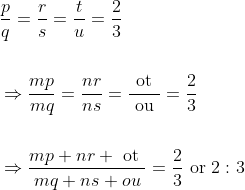
9 Ratio and Proportion - Trick #94
N/A
Two numbers are in the ratio a:b and if each number is increased by x, the ratio becomes c:d.
Then the two numbers will be
}{a&space;d-b&space;c}&space;\text&space;{&space;and&space;}&space;\frac{x&space;b(c-d)}{a&space;d-b&space;c})
Example:
If two numbers are in the ratio 2 : 3 and the ratio becomes 3 : 4 when 8 is
added to both the numbers, then the sum of the two numbers is?
Solution:
By Applying Trick 94,
Here, a = 2, b = 3, x= 8, c = 3, d = 4
}{a&space;d-b&space;c}&space;\\&space;\\&space;&=\frac{8&space;\times&space;2(3-4)}{2&space;\times&space;4-3&space;\times&space;3}&space;\\&space;\\&space;&=\frac{-16}{-1}=16&space;\end{aligned})
}{a&space;d-b&space;c}&space;\\&space;\\&space;&=\frac{8&space;\times&space;3(3-4)}{2&space;\times&space;4-3&space;\times&space;3}&space;\\&space;\\&space;&=\frac{-24}{-1}=24&space;\end{aligned})
Sum of numbers = 16 + 24 = 40
10 Ratio and Proportion - Trick #95
N/A
Two numbers are in the ratio a:b and if x is subtracted from each number the ratio becomes c:d.
The two numbers will be
}{a&space;d-b&space;c}&space;\text&space;{&space;and&space;}&space;\frac{x&space;b(d-c)}{a&space;d-b&space;c})
Example:
Two numbers are in the ratio 5 : 7. If 9 is subtracted from each of them, their ratio becomes 7 : 11. The difference of the numbers is?
Solution:
By Applying Trick 95,
Here, a = 5, b = 7, x = 9, c = 7, d = 11
}{a&space;d-b&space;c}&space;\\&space;\\&space;&=\frac{9&space;\times&space;5(11-7)}{5&space;\times&space;11-7&space;\times&space;7}&space;\\&space;\\&space;&=\frac{45&space;\times&space;4}{55-49}&space;\\&space;\\&space;&=\frac{45&space;\times&space;4}{6}&space;\\&space;\\&space;&=30&space;\end{aligned})
}{a&space;d-b&space;c}&space;\\&space;\\&space;&=\frac{9&space;\times&space;7(11-7)}{5&space;\times&space;11-7&space;\times&space;7}&space;\\&space;\\&space;&=\frac{63&space;\times&space;4}{55-49}&space;\\&space;\\&space;&=\frac{63&space;\times&space;4}{6}&space;\\&space;\\&space;&=42&space;\end{aligned})
If the ratio of present age and the ratio of age after ‘n’ years is given then present age factor is given by
&space;\times&space;\text&space;{&space;time&space;}}{(\text&space;{&space;Difference&space;in&space;cross&space;products&space;of&space;ratio&space;})})
If x is the present age factor, and the difference in cross product of ratio is zero then,
&space;}})
If the ratio of ‘some years ago’ and ‘after some years’ is given. And Before  years, the ratio of ages of A and B was a : b.
years, the ratio of ages of A and B was a : b.
)
)
after  years, the ratio of their ages will be c: d.
years, the ratio of their ages will be c: d.
&space;\times\left(&space;t&space;_{1}+&space;t&space;_{2}\right)}{\text&space;{&space;(Difference&space;in&space;cross&space;products&space;of&space;the&space;ratio)&space;}})
When, the difference in ratios is equal, then
}{(\text&space;{&space;Difference&space;in&space;ratio&space;})})
If the product of present ages is given, then,

If sum of present age and ratio of the ages is given then, present age factor,

If the ratio of ages and difference in ages is given then,

The ratio of ages of A and B was x: y ‘n’ years ago.
&space;If&space;the&space;present&space;age&space;ratio&space;is&space;a:&space;b,&space;then,&space;}&space;\frac{x+n}{y+n}=\frac{a}{b})
&space;If&space;after&space;'&space;}&space;m&space;^{\prime}&space;\text&space;{&space;years,&space;the&space;ratio&space;of&space;ages&space;will&space;be&space;})



:(y+n):(z+n))


:(y-m))
20 Mixture or Alligation- Trick #105
N/A
The cost of cheap object is Rs. C/kg and the cost of costly object is Rs. D/kg.
If the mixture of both object costs Rs. M/kg. then

:(M-C))
21 Mixture or Alligation- Trick #106
N/A
Quantity of x in mixture

22 Mixture or Alligation- Trick #107
N/A
If from x litre of liquid A, p litre is withdrawn and same quantity of liquid B is added. Again, from mixture q litre mixture is withdrawn and same quantity of liquid B is added. Again, from mixture, r litre is withdrawn and same quantity of liquid B is added, then In final mixture, liquid A is
\left(\frac{x-q}{x}\right)\left(\frac{x-r}{x}\right)&space;\ldots&space;\ldots&space;\ldots)
If only one process is repeated n times, then liquid A in final mixture is
^{n}&space;\text&space;{&space;or&space;}&space;x\left(1-\frac{p}{x}\right)^{n})
&space;})
23 Mixture or Alligation- Trick #108
N/A
If x is initial amount of liquid, p is the amount which is drawn, and this process is repeated n-times such that the resultant mixture is in the ratio a: b then,
^{&space;n&space;})
24 Mixture or Alligation- Trick #109
N/A
There are two pots of same volume. Both the pots contain mixture of milk and water in the ratio m:n and p:q respectively. If both the mixtures are mixed together in a big pot, then what will be the final ratio of milk and water?
:\left(\frac{n}{m+n}+\frac{q}{p+q}\right))
25 Mixture or Alligation- Trick #110
N/A



}{(a+b)&space;b_{1}}&space;\text&space;{&space;unit&space;})
If ‘d’ unit water is added to it then
}{(a+b)&space;a_{1}}&space;\text&space;{&space;unit&space;})
26 Mixture or Alligation- Trick #111
N/A
There is x% milk in ‘a’ unit mixture of milk and water.
The amount of milk that should be added to increase the percentage of milk from x% to y% is given by
}{(100-y)}&space;\text&space;{&space;unit.&space;})
27 Mixture or Alligation- Trick #112
N/A
There is x% water in ‘a’ unit the mixture of sugar and water.
The quantity of water vapourised such that decrease in the percentage of water is from x% to y% is given by

}{&space;y&space;}&space;\text&space;{&space;unit&space;})
28 Simple Interest : Formula
N/A
Principal or Sum:
The money borrowed or lent out for a certain period is called the principal or the sum.
Interest:
Extra money paid for using other’s money is called interest.
Simple Interest:
If the interest on a sum borrowed for a certain period is reckoned uniformly, then it is called simple interest.
Formulae:
Let Principal = P, Rate = R% per annum and time = T years.


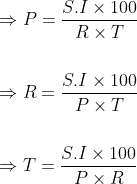
Example-1:
At some rate of simple interest, A lent $6000 to B for 2 years and $1500 to C for 4 years and received $900 as interest from both of them together. The rate of interest per annum was?
Solution:
If rate of interest be R% p.a. then,

Example-2:
$500 was invested at 12% per annum simple interest and a certain sum of money invested at 10% per annum simple interest. If the sum of the interest on both the sum after 4 years is $480, the latter sum of money is?
Solution:
Simple interest gained from $500

Let the other Principal be x.
S.I. gained = $(480 – 240) = $240
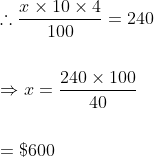
Example-3:
A lends $2500 to B and a certain sum to C at the same time at 7% annual simple interest. If after 4 years, A altogether receives $1120 as interest from B and C, the sum lent to C is?
Solution:
Let the sum lent to C be x According to the question,

or 2500 × 28 + 28x = 112000 or
2500 + x = 4000 or
x = 4000 – 2500 = 1500
29 Simple Interest - Trick #113
N/A
If there are distinct rates of interest for distinct time periods i.e.



}{100})
30 Simple Interest - Trick #114
N/A
If a certain sum becomes ‘n’ times of itself in T years on Simple Interest, then the rate per cent per annum is.
}{&space;T&space;}&space;\times&space;100&space;\%\)&space;and)
}{&space;R&space;}&space;\times&space;100&space;\%)
Example-1:
A sum of money becomes 7/6 of itself in 3 years at a certain rate of simple interest. The rate per annum is?
Solution:
By Applying Trick 114,
&space;\times&space;100&space;\%}{3}&space;\\&space;\\&space;&=\frac{1}{18}&space;\times&space;100&space;\%&space;\\&space;\\&space;&=\frac{50}{9}&space;\%&space;\\&space;\\&space;&=5&space;\frac{5}{9}&space;\%&space;\end{aligned})
Example-2:
In how many years will a sum of money double itself at  simple interest per annum?
simple interest per annum?
Solution:
By Applying Trick 114,
}{&space;R&space;\%}&space;\text&space;{&space;years&space;}&space;\\&space;\\&space;&=\frac{(2-1)}{\frac{25}{4}}&space;\times&space;100&space;\text&space;{&space;years&space;}&space;\\&space;\\&space;&=16&space;\text&space;{&space;years&space;}&space;\end{aligned})
31 Simple Interest - Trick #115
N/A


}{\left(&space;n&space;_{1}-1\right)}&space;R&space;_{1}&space;\text&space;{&space;and&space;}&space;T&space;_{2}=\frac{\left(&space;n&space;_{2}-1\right)}{\left(&space;n&space;_{1}-1\right)}&space;T&space;_{1})
32 Simple Interest - Trick #116
N/A
If Simple Interest (S.I.) becomes ‘n’ times of principal i.e.
S.I. = P × n then.
RT = n × 100
Example-1:
The simple interest on a sum after 4 years is 1/5 of the sum. The rate of interest per annum is?
Solution:
By Applying Trick 116,

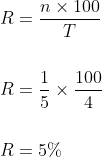
Example-2:
Simple interest on a certain sum for 6 years is 9/25 of the sum. The rate of interest is?
Solution:
By Applying Trick 116,

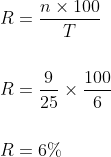
33 Simple Interest - Trick #117
N/A
If an Amount (A) becomes ‘n’ times of certain sum (P) i.e.

&space;\times&space;100)
34 Simple Interest - Trick #118
N/A
If the difference between two simple interests is ‘x’ calculated at different annual rates and times, then principal (P) is
&space;\times(\text&space;{&space;difference&space;in&space;time&space;})})
Example:
The difference between the simple interest received from two different
banks on $500 for 2 years is $2.50. The difference between their (per
annum) rate of interest is?
Solution:
By Applying Trick 118,
Here, P = $500, x = $2.50, Difference in time = 2 years.
Difference in rate =?
&space;\times&space;2})
Different in rate = 0.25%
35 Simple Interest - Trick #119
N/A


&space;\times&space;100}{(\text&space;{&space;Change&space;in&space;interest&space;Rate&space;})&space;\times&space;\text&space;{&space;time&space;}})
36 Simple Interest - Trick #120
N/A


&space;\times&space;100}{A&space;\cdot&space;t_{2}-B&space;\cdot&space;t_{1}})
and

37 Simple Interest - Trick #121
N/A
If a sum is to be deposited in equal instalments, then,
![\text { Equal installment }=\frac{ A \times 200}{ T [200+( T -1) r ]}](https://latex.codecogs.com/gif.latex?\text&space;{&space;Equal&space;installment&space;}=\frac{&space;A&space;\times&space;200}{&space;T&space;[200+(&space;T&space;-1)&space;r&space;]})
Example-1:
What annual instalment will discharge a debt of $6450 due in 4 years at 5% simple interest?
Solution:
By Applying Trick 121,
![\begin{aligned} &=\frac{6450 \times 200}{4[200+(4-1) \times 5]} \\ \\ &=\frac{6450 \times 200}{4(215)} \\ \\ &=\frac{6450 \times 50}{215} \\ \\ &=\$ 1500 \end{aligned}](https://latex.codecogs.com/gif.latex?\begin{aligned}&space;&=\frac{6450&space;\times&space;200}{4[200+(4-1)&space;\times&space;5]}&space;\\&space;\\&space;&=\frac{6450&space;\times&space;200}{4(215)}&space;\\&space;\\&space;&=\frac{6450&space;\times&space;50}{215}&space;\\&space;\\&space;&=\$&space;1500&space;\end{aligned})
Example-2:
What equal instalment of annual payment will discharge a debt which is due as $848 at the end of 4 years at 4% per annum simple interest?
Solution:
By Applying Trick 121,
Here, A = $848, T = 4 years, r = 4%
![\begin{aligned} &=\frac{848 \times 200}{4[200+(4-1) 4]} \\ \\ &=\frac{848 \times 200}{4 \times 212} \\ \\ &=\$ 200 \end{aligned}](https://latex.codecogs.com/gif.latex?\begin{aligned}&space;&=\frac{848&space;\times&space;200}{4[200+(4-1)&space;4]}&space;\\&space;\\&space;&=\frac{848&space;\times&space;200}{4&space;\times&space;212}&space;\\&space;\\&space;&=\$&space;200&space;\end{aligned})
38 Simple Interest - Trick #122
N/A
To find the rate of interest under current deposit plan,
&space;\times(\text&space;{&space;deposited&space;amount&space;})})
where n = no. of months
39 Simple Interest - Trick #124
N/A




Example-1:
The simple interest on a certain sum at 5% per annum for 3 years and 4
years differ by $42. The sum is?
Solution:
By Applying Trick 124,




Example-2:
The difference between the simple interest received from two different sources on $1500 for 3 years is 413.50. The difference between their rates of interest is?
Solution:
By Applying Trick 124




}{100})



40 Simple Interest - Trick #123
N/A


&space;}&space;R=\left(\frac{A_{1}-A_{2}}{A_{2}&space;T_{1}-A_{1}&space;T_{2}}\right)&space;\times&space;100)
&space;}&space;P=\left(\frac{A_{2}&space;T&space;_{1}-A_{1}&space;T&space;_{2}}{&space;T&space;_{1}-&space;T&space;_{2}}\right))
Example:
A sum of money lent at simple interest amounts to $880 in 2 years and to $920 in 3 years. The sum of money (in dollars) is?
Solution:
&space;\\&space;\\&space;&=\left(\frac{920&space;\times&space;2-880&space;\times&space;3}{2-3}\right)&space;\\&space;\\&space;&=\left(\frac{1840-2640}{-1}\right)&space;\\&space;\\&space;&=\frac{-800}{-1}&space;\\&space;\\&space;&=\$&space;800&space;\end{aligned})
41 Compound Interest : Formula
N/A
Sometimes it so happens that the borrower and the lender agree to fix up a certain unit of time, say yearly or half yearly or quarterly to settle the previous account. In such case, the amount after first unit of time becomes the principal for the second unit, the amount after second unit becomes the principal for the third unit and so on. After a specified period, the difference between the amount and the money borrowed is called the Compound Interest (abbreviated as C.I.) for that period.
Let Principal = P, Rate = R% per annum, Time = n years.
^{&space;n&space;})
![\text { When interest is compounded Half - yearly: Amount }= P \left[1+\frac{( R / 2)}{100}\right]^{2 n }](https://latex.codecogs.com/gif.latex?\text&space;{&space;When&space;interest&space;is&space;compounded&space;Half&space;-&space;yearly:&space;Amount&space;}=&space;P&space;\left[1+\frac{(&space;R&space;/&space;2)}{100}\right]^{2&space;n&space;})
![\text { When interest is compounded Quarterly: Amount }= P \left[1+\frac{( R / 4)}{100}\right]^{4 n }](https://latex.codecogs.com/gif.latex?\text&space;{&space;When&space;interest&space;is&space;compounded&space;Quarterly:&space;Amount&space;}=&space;P&space;\left[1+\frac{(&space;R&space;/&space;4)}{100}\right]^{4&space;n&space;})

^{3}&space;\times\left(1+\frac{\frac{2}{5}&space;R}{100}\right))
Example-1:
The compound interest on $10,000 in 2 years at 4% per annum, the interest being compounded half-yearly, is?
Solution:
^{4}&space;\\&space;\\&space;&=10,000\left(\frac{51}{50}\right)^{4}=10824.3216&space;\end{aligned})


Example-2:
In what time will 1000 becomes 1331 at 10% per annum compounded annually?
Solution:
Let the required time be n years. Then,
![\begin{aligned} &1331=1000\left(1+\frac{10}{100}\right)^{ n } \\ \\ &{\left[\therefore P _{1}= P \left(1+\frac{ r }{100}\right)^{ n }\right]} \\ \\ &\Rightarrow \frac{1331}{1000}=\left(\frac{10+1}{10}\right)^{ n } \\ \\ &\Rightarrow\left(\frac{11}{10}\right)^{ n }=\left(\frac{11}{10}\right)^{3} \\ \\ &\Rightarrow n =3 \end{aligned}](https://latex.codecogs.com/gif.latex?\begin{aligned}&space;&1331=1000\left(1+\frac{10}{100}\right)^{&space;n&space;}&space;\\&space;\\&space;&{\left[\therefore&space;P&space;_{1}=&space;P&space;\left(1+\frac{&space;r&space;}{100}\right)^{&space;n&space;}\right]}&space;\\&space;\\&space;&\Rightarrow&space;\frac{1331}{1000}=\left(\frac{10+1}{10}\right)^{&space;n&space;}&space;\\&space;\\&space;&\Rightarrow\left(\frac{11}{10}\right)^{&space;n&space;}=\left(\frac{11}{10}\right)^{3}&space;\\&space;\\&space;&\Rightarrow&space;n&space;=3&space;\end{aligned})
Example-3:
The principal, which will amount to $270.40 in 2 years at the rate of 4% per annum compound interest, is?
Solution:
Let the principal be $P
^{2}&space;\\&space;\\&space;&\Rightarrow&space;270.40=&space;P&space;(1+0.04)^{2}&space;\\&space;\\&space;&\Rightarrow&space;P&space;=\frac{270.40}{1.04&space;\times&space;1.04}&space;\\&space;\\&space;&=\$&space;250&space;\end{aligned})
42 Compound Interest - Trick #125
N/A
If there are distinct ‘rates of interest’ for distinct time periods i.e.,



\left(1+\frac{&space;r&space;_{2}}{100}\right)\left(1+\frac{&space;r&space;_{3}}{100}\right))
C.I. = A – P
Example:
If the rate of interest be 4% per annum for first year, 5% per annum for second year and 6% per annum for third year, then the compound interest of $10,000 for 3 years will be?
Solution:
By Applying Trick 125,
\left(1+\frac{R_{2}}{100}\right)\left(1+\frac{R_{3}}{100}\right)&space;\\&space;\\&space;&=10000\left(1+\frac{4}{100}\right)\left(1+\frac{5}{100}\right)\left(1+\frac{6}{100}\right)&space;\\&space;\\&space;&=10000&space;\times&space;\frac{26}{25}&space;\times&space;\frac{21}{20}&space;\times&space;\frac{53}{50}&space;\end{aligned})
A = $11575.2
C.I. = $(11575.2–10000)
= $1575.2
43 Compound Interest - Trick #126
N/A
If the time is in fractional form i.e., t = nF, then
^{n}\left(1+\frac{r&space;F}{100}\right)&space;\text&space;{&space;e.g.t&space;}=3&space;\frac{5}{7}&space;y&space;r&space;s&space;\text&space;{,&space;then&space;})
^{3}\left(1+\frac{r}{100}&space;\times&space;\frac{5}{7}\right))
Example:
Find compound interest on 10,000 for  years at 10% per annum, compounded yearly?
years at 10% per annum, compounded yearly?
Solution:
By Applying Trick 126,
^{3}\left(1+\frac{\frac{r}{2}}{100}\right)&space;\\&space;\\&space;&=10,000\left(1+\frac{10}{100}\right)^{3}\left(1+\frac{5}{100}\right)&space;\\&space;\\&space;&=10,000&space;\times&space;\frac{1331}{1000}&space;\times&space;\frac{21}{20}&space;\end{aligned})
A = $13975.5
CI = $(13975.5 – 10,000)
CI = $3975.5
44 Compound Interest - Trick #127
N/A
A certain sum becomes ‘m’ times of itself in ‘t’ years on compound interest then the time it will take to become mn times of itself is t × n years.
Example:
A sum of money placed at compound interest doubles itself in 5 years. In how many years, it would amount to eight times of itself at the same rate of interest?
Solution:
By Applying Trick 127,



45 Compound Interest - Trick #128
N/A
The difference between C.I. and S.I. on a sum ‘P’ in 2 years at the rate of R% rate of compound interest will be
^{2}=\frac{\text&space;{&space;S.I.&space;}&space;\times&space;R&space;}{200})
^{2}&space;\times\left(3+\frac{R}{100}\right))
Example:
If the difference between the compound interest and simple interest on a sum at 5% rate of interest per annum for three years is 36.60, then the sum is?
Solution:
By Applying Trick 128,
^{2}&space;\times\left(3+\frac{R}{100}\right)&space;\\&space;\\&space;&36.60=P\left(\frac{5}{100}\right)^{2}&space;\times\left(3+\frac{5}{100}\right)&space;\\&space;\\&space;&36.60=P&space;\times&space;\frac{25}{100^{2}}&space;\times&space;\frac{305}{100}&space;\\&space;\\&space;&P=\frac{36.60&space;\times&space;100&space;\times&space;100&space;\times&space;100}{25&space;\times&space;305}&space;\\&space;\\&space;&P=\frac{36600000}{25&space;\times&space;305}=\$&space;4800&space;\end{aligned})
46 Compound Interest - Trick #129
N/A
If on compound interest, a sum becomes A in ‘a’ years and B in ‘b’ years then,
&space;If&space;}&space;b&space;-&space;a&space;=1&space;\text&space;{,&space;then,&space;}&space;R&space;\%=\left(\frac{&space;B&space;}{&space;A&space;}-1\right)&space;\times&space;100&space;\%)
&space;If&space;}&space;b-a=2&space;\text&space;{,&space;then,&space;}&space;R&space;\%=\left(\sqrt{\frac{B}{A}}-1\right)&space;\times&space;100&space;\%)
![\text { (iii) If } b-a=n \text { then, } R \%=\left[\left(\frac{B}{A}\right)^{\frac{1}{n}}-1\right] \times 100 \%](https://latex.codecogs.com/gif.latex?\text&space;{&space;(iii)&space;If&space;}&space;b-a=n&space;\text&space;{&space;then,&space;}&space;R&space;\%=\left[\left(\frac{B}{A}\right)^{\frac{1}{n}}-1\right]&space;\times&space;100&space;\%)
where n is a whole number
Example:
A sum of money amounts to $4,840 in 2 years and to $5,324 in 3 years at compound interest compounded annually. The rate of interest per annum is?
Solution:
By Applying Trick 129,
Here, b – a = 3 – 2 = 1 B = $5,324, A = $4,840
&space;\times&space;100&space;\%&space;\\&space;\\&space;&=\left(\frac{5324}{4840}-1\right)&space;\times&space;100&space;\%&space;\\&space;\\&space;&=\left(\frac{5324-4840}{4840}\right)&space;\times&space;100&space;\%&space;\\&space;\\&space;&=\frac{484}{4840}&space;\times&space;100&space;\%&space;\\&space;\\&space;&=10&space;\%&space;\end{aligned})
47 Compound Interest - Trick #130
N/A
If a sum becomes ‘n’ times of itself in ‘t’ years on compound interest, then
![R \%=\left[ n ^{\frac{1}{ t }}-1\right] \times 100 \%](https://latex.codecogs.com/gif.latex?R&space;\%=\left[&space;n&space;^{\frac{1}{&space;t&space;}}-1\right]&space;\times&space;100&space;\%)
Example:
If the amount is 2.25 times of the sum after 2 years at compound interest (compound annually), the rate of interest per annum is?
Solution:
By Applying Trick 130,
Here, n = 2.25, t = 2 years
![\begin{aligned} & R \%=\left( n ^{\frac{1}{t}}-1\right) \times 100 \% \\ \\ & R \%=\left[(2.25)^{\frac{1}{2}}-1\right] \times 100 \% \\ \\ &=[1.5-1] \times 100 \% \\ \\ &=0.5 \times 100 \% \\ \\ &=50 \% \end{aligned}](https://latex.codecogs.com/gif.latex?\begin{aligned}&space;&&space;R&space;\%=\left(&space;n&space;^{\frac{1}{t}}-1\right)&space;\times&space;100&space;\%&space;\\&space;\\&space;&&space;R&space;\%=\left[(2.25)^{\frac{1}{2}}-1\right]&space;\times&space;100&space;\%&space;\\&space;\\&space;&=[1.5-1]&space;\times&space;100&space;\%&space;\\&space;\\&space;&=0.5&space;\times&space;100&space;\%&space;\\&space;\\&space;&=50&space;\%&space;\end{aligned})
48 Compound Interest - Trick #131
N/A
If a sum ‘P’ is borrowed at r% annual compound interest which is to be paid in ‘n’ equal annual installments including interest, then
&space;for&space;}&space;n=2&space;\text&space;{,&space;Each&space;annual&space;installment&space;})
+\left(\frac{100}{100+r}\right)^{2}})
&space;For&space;}&space;n=3&space;\text&space;{,&space;Each&space;annual&space;instalment&space;})
+\left(\frac{100}{100+r}\right)^{2}+\left(\frac{100}{100+r}\right)^{3}})
Example:
A builder borrows $2550 to be paid back with compound interest at the rate of 4% per annum by the end of 2 years in two equal yearly instalments.
How much will each instalment be?
Solution:
By Applying Trick 131,
Here, P = $2550, n = 2, r = 4%
+\left(\frac{100}{100+&space;r&space;}\right)^{2}}&space;\\&space;\\&space;&=\frac{2550}{\left(\frac{100}{100+4}\right)+\left(\frac{100}{100+4}\right)^{2}}&space;\\&space;\\&space;&=\frac{2550}{\frac{100}{104}+\left(\frac{100}{104}\right)^{2}}&space;\\&space;\\&space;&=\frac{2550}{\frac{100}{104}\left(1+\frac{100}{104}\right)}&space;\\&space;\\&space;&=\frac{2550}{\frac{100}{104}\left(\frac{204}{104}\right)}&space;\\&space;\\&space;&=\frac{2550&space;\times&space;104&space;\times&space;104}{20400}&space;\\&space;\\&space;&=\$&space;1352&space;\end{aligned})
49 Compound Interest - Trick #132
N/A
The simple interest for a certain sum for 2 years at an annual rate interest R% is S.I., then
)
Example:
If the compound interest on a sum for 2 years at  per annum is $510, the simple interest on the same sum at the same rate for the same period of time is?
per annum is $510, the simple interest on the same sum at the same rate for the same period of time is?
Solution:
By Applying Trick 132,
Here, C.I. = $510
&space;\\&space;\\&space;&510=\text&space;{&space;S.I.&space;}\left(1+\frac{25}{400}\right)&space;\\&space;\\&space;&\text&space;{&space;S.I.&space;}=\frac{510&space;\times&space;400}{425}&space;\\&space;\\&space;&\text&space;{&space;S.I.&space;}=\$&space;480&space;\end{aligned})
50 Compound Interest - Trick #133
N/A


Example-1:
A sum of $12,000, deposited at compound interest becomes double after 5 years. How much will it be after 20 years?
Solution:
By Applying Trick 133,
^{20}&space;\\&space;\\&space;&y=2^{4}&space;\\&space;\\&space;&y=16&space;\text&space;{&space;times&space;}&space;\end{aligned})
Example-2:
A sum of money becomes double in 3 years at compound interest compounded annually. At the same rate, in how many years will it become four times of itself?
Solution:

^{\frac{1}{n_{2}}}&space;\\&space;\\&space;&\Rightarrow&space;2^{\frac{1}{3}}=2^{\frac{2}{n_{2}}}&space;\\&space;\\&space;&\frac{1}{3}=\frac{2}{n_{2}}&space;\\&space;\\&space;&\therefore&space;n_{2}=6&space;\text&space;{&space;years&space;}&space;\end{aligned})
Example-3:
A sum of money placed at compound interest doubles itself in 4 years. In how many years will it amount to four times itself?
Solution:



^{\frac{1}{4}}=(4)^{\frac{1}{&space;n&space;_{2}}}\))
^{\frac{1}{4}}=\left(2^{2}\right)^{\frac{1}{n_{2}}}\))
^{\frac{1}{4}}=(2)^{\frac{2}{n_{2}}}\))

51 Time and Work - Formula
N/A
Work Word Problem:
 It involves a number of people or machines working together to complete a task.
It involves a number of people or machines working together to complete a task.
 We are usually given individual rates of completion.
We are usually given individual rates of completion.
 We are asked to find out how long it would take if they work together.
We are asked to find out how long it would take if they work together.
- The Work Problem Concept:
STEP 1: Calculate how much work each person/machine does in one unit of time (could be days, hours, minutes, etc.)
 If we are given that A completes a certain amount of work in X hours, simply reciprocate the number of hours to get the per hour work. Thus, in one hour, A would complete
If we are given that A completes a certain amount of work in X hours, simply reciprocate the number of hours to get the per hour work. Thus, in one hour, A would complete  of the work. But what is the logic behind this?
of the work. But what is the logic behind this?
 Let me explain with the help of an example.
Let me explain with the help of an example.
 Assume we are given that Jack paints a wall in 5 hours. This means that in every hour, he completes a fraction of the work so that at the end of 5 hours, the fraction of work he has completed will become 1 (that means he has completed the task).
Assume we are given that Jack paints a wall in 5 hours. This means that in every hour, he completes a fraction of the work so that at the end of 5 hours, the fraction of work he has completed will become 1 (that means he has completed the task).
 Thus, if in 5 hours the fraction of work completed is 1, then in 1 hour, the fraction of work completed will be (1*1)/5
Thus, if in 5 hours the fraction of work completed is 1, then in 1 hour, the fraction of work completed will be (1*1)/5
STEP 2: Add up the amount of work done by each person/machine in that one unit of time.
 This would give us the total amount of work completed by both of them in one hour. For example, if A completes
This would give us the total amount of work completed by both of them in one hour. For example, if A completes  of the work in one hour and B completes
of the work in one hour and B completes  of the work in one hour, then TOGETHER, they can complete
of the work in one hour, then TOGETHER, they can complete  of the work in one hour.
of the work in one hour.
STEP 3: Calculate total amount of time taken for work to be completed when all persons/machines are working together.
 The logic is similar to one we used in STEP 1, the only difference being that we use it in reverse order.
The logic is similar to one we used in STEP 1, the only difference being that we use it in reverse order.
 Suppose
Suppose 
 This means that in one hour, A and B working together will complete
This means that in one hour, A and B working together will complete  of the work. Therefore, working together, they will complete the work in Z hours.
of the work. Therefore, working together, they will complete the work in Z hours.
Example-1:
 Jack can paint a wall in 3 hours. John can do the same job in 5 hours. How long will it take if they work together?
Jack can paint a wall in 3 hours. John can do the same job in 5 hours. How long will it take if they work together?
Solution:
 This is a simple straightforward question wherein we must just follow steps 1 to 3 in order to obtain the answer.
This is a simple straightforward question wherein we must just follow steps 1 to 3 in order to obtain the answer.
 STEP 1: Calculate how much work each person does in one hour.
STEP 1: Calculate how much work each person does in one hour.
 Jack → (1/3) of the work
Jack → (1/3) of the work
 John → (1/5) of the work
John → (1/5) of the work
 STEP 2: Add up the amount of work done by each person in one hour.
STEP 2: Add up the amount of work done by each person in one hour.
 Work done in one hour when both are working together
Work done in one hour when both are working together 
 STEP 3: Calculate total amount of time taken when both work together.
STEP 3: Calculate total amount of time taken when both work together.
 If they complete 8/15 of the work in 1 hour, then they would complete 1 job in 15/8 hours.
If they complete 8/15 of the work in 1 hour, then they would complete 1 job in 15/8 hours.
Example-2:
 Working, independently X takes 12 hours to finish a certain work. He finishes 2/3 of the work. The rest of the work is finished by Y whose rate is 1/10 of X. In how much time does Y finish his work?
Working, independently X takes 12 hours to finish a certain work. He finishes 2/3 of the work. The rest of the work is finished by Y whose rate is 1/10 of X. In how much time does Y finish his work?
Solution:
 Now the only reason this is trickier than the first problem is because the sequence of events is slightly more complicated. The concept however is the same. So, if our understanding of the concept is clear, we should have no trouble at all dealing with this.
Now the only reason this is trickier than the first problem is because the sequence of events is slightly more complicated. The concept however is the same. So, if our understanding of the concept is clear, we should have no trouble at all dealing with this.
 ‘Working, independently X takes 12 hours to finish a certain work’ This statement tells us that in one hour, X will finish 1/12 of the work.
‘Working, independently X takes 12 hours to finish a certain work’ This statement tells us that in one hour, X will finish 1/12 of the work.
 ‘He finishes 2/3 of the work’, This tells us that 1/3 of the work still remains.
‘He finishes 2/3 of the work’, This tells us that 1/3 of the work still remains.
 ‘The rest of the work is finished by Y whose rate is (1/10) of X’ Y has to complete 1/3 of the work.
‘The rest of the work is finished by Y whose rate is (1/10) of X’ Y has to complete 1/3 of the work.
 ‘Y's rate is (1/10) that of X‘. We have already calculated rate at which X works to be 1/12. Therefore, rate at which Y works is
‘Y's rate is (1/10) that of X‘. We have already calculated rate at which X works to be 1/12. Therefore, rate at which Y works is 
 ‘In how much time does Y finish his work?’ If Y completes 1/120 of the work in 1 hour, then he will complete 1/3 of the work in 40 hours.
‘In how much time does Y finish his work?’ If Y completes 1/120 of the work in 1 hour, then he will complete 1/3 of the work in 40 hours.
 So, as you can see, even though the question might have been a little difficult to follow at first reading, the solution was in fact quite simple. We didn’t use any new concepts. All we did was apply our knowledge of theconcept we learnt earlier to the information in the question in order to answer what was being asked.
So, as you can see, even though the question might have been a little difficult to follow at first reading, the solution was in fact quite simple. We didn’t use any new concepts. All we did was apply our knowledge of theconcept we learnt earlier to the information in the question in order to answer what was being asked.
Example-3:
 Working together, printer A and printer B would finish a task in 24 minutes. Printer A alone would finish the task in 60 minutes. How many pages does the task contain if printer B prints 5 pages a minute more than printer A?
Working together, printer A and printer B would finish a task in 24 minutes. Printer A alone would finish the task in 60 minutes. How many pages does the task contain if printer B prints 5 pages a minute more than printer A?
Solution:
 This problem is interesting because it tests not only our knowledge of the concept of word problems, but also our ability to ‘translate English to Math’ ‘Working together, printer A and printer B would finish a task in 24 minutes’ This tells us that A and B combined would work at the rate of 1/24 per minute.
This problem is interesting because it tests not only our knowledge of the concept of word problems, but also our ability to ‘translate English to Math’ ‘Working together, printer A and printer B would finish a task in 24 minutes’ This tells us that A and B combined would work at the rate of 1/24 per minute.
 ‘Printer A alone would finish the task in 60 minutes’ This tells us that A works at a rate of 1/60 per minute.
‘Printer A alone would finish the task in 60 minutes’ This tells us that A works at a rate of 1/60 per minute.
 At this point, it should strike you that with just this much information, it is possible to calculate the rate at which B works:
At this point, it should strike you that with just this much information, it is possible to calculate the rate at which B works:

 ‘B prints 5 pages a minute more than printer A’ This means that the difference between the amount of work B and
‘B prints 5 pages a minute more than printer A’ This means that the difference between the amount of work B and
 A complete in one minute corresponds to 5 pages. So, let us calculate that difference.
A complete in one minute corresponds to 5 pages. So, let us calculate that difference.

 ‘How many pages does the task contain?’ If 1/120 of the job consists of 5 pages, then the 1 job will consist of
‘How many pages does the task contain?’ If 1/120 of the job consists of 5 pages, then the 1 job will consist of }{\frac{1}{120}}=600\&space;pages.)
Example-4:
Machine A and Machine B are used to manufacture 660 sprockets. It takes machine A ten hours longer to produce 660 sprockets than machine B.
Machine B produces 10% more sprockets per hour than machine A. How many sprockets per hour does machine A produce?
Solution:


We are told that B produces 10% more sprockets per hour than A, thus


52 Time and Work - Trick #134
N/A
If M1 men can finish W1 work in D1 days and M2 men can finish M2 work in D2 days then, Relation is

If M1 men finish W1 work in D1 days, working T1 time each day and M2 men finish W2 work in D2 days, working T2 time each day, then

53 Time and Work - Trick #135
N/A
If A completes a piece of work in ‘x’ days, and B completes the same work in ‘y’ days, then,
Work done by A in 1 day = 1/x, Work done by B in 1 day = 1/y

)
54 Time and Work - Trick #136
N/A
If A can do a work in ‘x’ days, B can do the same work in ‘y’ days, C can do the same work in ‘z’ days then, total time taken by A, B and C to complete

If workers are more than 3 then total time taken by A, B, C ...... so on to

Example:
A, B and C individually can do a work in 10 days, 12 days and 15 days respectively. If they start working together, then the number of days required to finish the work is?
Solution:
By Applying Trick 136,




55 Time and Work - Trick #137
N/A
If A alone can do a certain work in ‘x’ days and A and B together can do the same work in ‘y’ days, then B alone can do the same work in
\mathrm{\&space;days})
Example:
A and B together can dig a trench in 12 days, which A alone can dig in 28 days; B alone can dig it in
Solution:
By Applying Trick 137,



56 Time and Work - Trick #138
N/A
If A and B can do a work in ‘x’ days, B and C can do the same work in ‘y’ days, C and A can do the same work in ‘z’ days.
Then total time taken, when A, B and C work together
}\mathrm{\&space;OR\&space;}\frac{2xyz}{xy+yz+zx}\&space;days)
Example:
A and B can do a given piece of work in 8 days, B and C can do the same work in 12 days and A, B, C complete it in 6 days. Number of days required to finish the work by A and C is?
Solution:
By Applying Trick 138,
Let the time taken by A and C is x days





57 Time and Work - Trick #139
N/A

Total work = (work of one day) × (total no. of working days) Remaining
Work = 1 – (work done)
Work done by A = (Work done in 1 day by A) × (total no. of days worked by A, B and C and so on
})
Where A can complete work in x days, B in y days, C in z days and so on.
58 Time and Work - Trick #140
N/A
If A can finish m/n part of the work in D days. Then, Total time taken to finish the work by
}=\frac{n}{m}\times&space;D\mathrm{\&space;days})
59 Time and Work - Trick #141
N/A
(i) If A can do a work in ‘x’ days and B can do the same work in ‘y’ days and when they started working together, B left the work ‘m’ days before
x}{x+y})
(ii) A leaves the work ‘m’ days before its completion then total time taken
y}{x+y})
Example-1:
A can do a piece of work in 18 days and B in 12 days. They began the work together, but B left the work 3 days before its completion. In how many days, in all, was the work completed?
Solution:
By Applying Trick 141(i),
Here, x = 18, y = 12, m = 3
x)
\times18=9\mathrm{\&space;days})
Example-2:
A and B alone can complete work in 9 days and18 days respectively. They worked together; however, 3 days before the completion of the work A left. In how many days was the work completed?
Solution:
By Applying Trick 141(ii),
Here, x = 9, y = 18, m = 3
Total time taken
y}{x+y})
\times18}{9+18})


60 Time and Work - Trick #142
N/A
If A and B together can finish a certain work in ‘a’ days. They worked together for ‘b’ days and then ‘B’ (or A) left the work. A (or B) finished the rest work in ‘d’ days, then Total time taken by A (or B) alone to complete the work

Example:
A and B can together finish a work in 30 days. They worked at it for 20 days and then B left. The remaining work was done by A alone in 20 more days.
A alone can finish the work in?
Solution:
By Applying Trick 142,
Here, a = 30, b = 20, d = 20



61 Time and Work - Trick #144
N/A

![Required\ time=\frac{D_1D_2\left[A_1B_2-A_2B_1\right]}{D_1\left[A_1B_3-A_3B_1\right]-D_2\left[A_2B_3-A_3B_2\right]}\mathrm{\ days}](https://latex.codecogs.com/gif.latex?Required\&space;time=\frac{D_1D_2\left[A_1B_2-A_2B_1\right]}{D_1\left[A_1B_3-A_3B_1\right]-D_2\left[A_2B_3-A_3B_2\right]}\mathrm{\&space;days})
Example:
4 men and 6 women can complete a work in 8 days, while 3 men and 7 women can complete it in 10 days. In how many days will 10 women complete it?
Solution:
By Applying Trick 144,



![Required\ time=\frac{D_1D_2\left[A_1B_2-A_2B_1\right]}{D_1\left[A_1B_3-A_3B_1\right]-D_2\left[A_2B_3-A_3B_2\right]}](https://latex.codecogs.com/gif.latex?Required\&space;time=\frac{D_1D_2\left[A_1B_2-A_2B_1\right]}{D_1\left[A_1B_3-A_3B_1\right]-D_2\left[A_2B_3-A_3B_2\right]})
}{8(4\times10-0\times6)-10(3\times10-0\times7)})


62 Time and Work - Trick #143
N/A
If food is available for ‘a’ days for ‘A’ men at a certain place and after ‘b’ days. ‘B’ men join, then the remaining food will serve total men for
}{(A+B)}\mathrm{\&space;days})
If food is available for ‘a’ days for ‘A’ men at a certain place, and after ‘b’ days ‘B’ men leave then the remaining food will serve remaining men for
}{(A-B)}\mathrm{\&space;days})
Example:
40 men can complete a work in 18 days. Eight days after they started working together, 10 more men joined them. How many days will they now take to complete the remaining work?
Solution:
By Applying Trick 143,
Here, A = 40, a = 18
b = 8, B = 10
}{A+B})
}{40+10})


63 Time and Work - Trick #145
N/A

}{A_1B+B_1A}\&space;\&space;days)
Example:
If 8 men or 12 boys can do a piece of work in 16 days, the number of days required to complete the work by 20 men and 6 boys is?
Solution:
Here, A = 8, B = 12, a = 16




64 Time and Work - Trick #146
N/A


Example:
If 1 man or 2 women or 3 boys can complete a piece of work in 88 days,then 1 man, 1 woman and 1 boy together will complete it in?
Solution:






65 Time and Work - Trick #147
N/A
If ‘A’ men can do a certain work in ‘a’ days and ‘B’ women can do the same work in ‘b’ days, then the total time taken when A1 men and B1 women work together is
})


})
Example-1:
5 men can do a piece of work in 6 days while 10 women can do it in 5 days.
In how many days can 5 women and 3 men do it?
Solution:


})



Example-2:
A man, a woman and a boy can complete a work in 20 days, 30 days and 60 days respectively. How many boys must assist 2 men and 8 women so as to complete the work in 2 days?
Solution:


})



66 Time and Work - Trick #148
N/A
The comparison of rate of work done is called efficiency of doing work.
\propto\frac{1}{\mathrm{\&space;No.\&space;of\&space;days\&space;}})


Example:
Mike can do a work in 15 days. John is 50 per cent more efficient than
Mike in doing the work. In how many days will John do that work?
Solution:
Efficiency and time taken are inversely proportional
)
\&space;}=2:3)


Hence, John completes the work in 10 days.
67 Time and Work - Trick #149
N/A
If the efficiency to work of A is twice the efficiency to work of B, then,
=\&space;2x\&space;:&space;x\&space;and\&space;A\&space;:&space;B\&space;\left(time\right)=\&space;t\&space;:2t)
Example:
A man and a boy received $800 as wages for 5 days for the work they did
together. The man’s efficiency in the work was three times that of the boy.
What are the daily wages of the boy?
Solution:



68 Time and Work - Trick #150
N/A
If A can do a work in ‘x’ days and B is R% more efficient than A, then ‘B’ alone will do the same work in
}\mathrm{\&space;days})
Example:
A can do a piece of work in 70 days and B is 40% more efficient than A. The number of days taken by B to do the same work is?
Solution:
Here, x = 70, r = 40%



69 Time and Work - Trick #151
N/A
A, B and C can do a certain work together within ‘x’ days. While, any two of them can do the same work separately in ‘y’ and ‘z’ days, then in how many days can 3rd do the same work
}\mathrm{\&space;days})
Example:
A, B and C can complete a work in 8 days. B alone can do it in 18 days and C alone can do it in 24 days. In how many days can A alone do the same work?
Solution:
Here, x = 8, y = 18, z = 24
})
})



70 Time and Work - Trick #152
N/A
A and B can do a work in ‘x’ days, B and C can do the same work in ‘y’ days. C and A can do the same work in ‘z’ days.
Then, all can do alone the work as following:



Example-1:
A and B can do a piece of work in 10 days. B and C can do it in 12 days. A and C can do it in 15 days. How long will A take to do it alone?
Solution:





Example-2:
If A and B together can complete a work in 18 days, A and C together in 12 days and B and C together in 9 days, then B alone can do the work in?
Solution:





Example-3:
A and B can do a piece of work in 10 days. B and C can do it in 12 days. C and A in 15 days. In how many days will C finish it alone?
Solution:





71 Time and Work - Trick #153
N/A
A can do a certain work in ‘m’ days and B can do the same work in ‘n’ days.
They worked together for ‘P’ days and after this A left the work, then in how many days did B alone do the rest of work
}{m}\mathrm{\&space;days})
when after ‘P’ days B left the work, then in how many days did A alone do the rest of work
}{n}\mathrm{\&space;days})
Example-1:
A can do a piece of work in 12 days and B in 15 days. They work together for 5 days and then B left. The days taken by A to finish the remaining work is?
Solution:
Here, m = 12, n = 15, p = 5
}{n}\mathrm{\&space;days\&space;})
}{15})


Example-2:
A can do a piece of work in 12 days and B can do it in 18 days. They work together for 2 days and then A leaves. How long will B take to finish the remaining work?
Solution:
Here, m = 12, n = 18, p = 2
Time taken by B
}{m})
}{12})


72 Time and Work - Trick #154
N/A


![\mathrm{\ Required\ time\ }=\left[\frac{\left(h_1d_1\right)\times\left(h_2d_2\right)}{\left(h_1d_1+h_2d_2\right)}\right]\frac{1}{h}](https://latex.codecogs.com/gif.latex?\mathrm{\&space;Required\&space;time\&space;}=\left[\frac{\left(h_1d_1\right)\times\left(h_2d_2\right)}{\left(h_1d_1+h_2d_2\right)}\right]\frac{1}{h})
Example:
While working 7 hours a day, A alone can complete a piece of work in 6 days and B alone in 8 days. In what time would they complete it together, working 8 hours a day?
Solution:


![\mathrm{Required\ time\ }=\left[\frac{\left(h_1d_1\right)\times\left(h_2d_2\right)}{\left(h_1d_1+h_2d_2\right)}\right]\frac{1}{h}](https://latex.codecogs.com/gif.latex?\mathrm{Required\&space;time\&space;}=\left[\frac{\left(h_1d_1\right)\times\left(h_2d_2\right)}{\left(h_1d_1+h_2d_2\right)}\right]\frac{1}{h})
![=\left[\frac{(6\times6)\times(6\times8)}{6\times6+6\times8}\right]\times\frac{1}{8}](https://latex.codecogs.com/gif.latex?=\left[\frac{(6\times6)\times(6\times8)}{6\times6+6\times8}\right]\times\frac{1}{8})



73 Time and Work - Trick #155
N/A
The efficiency of A to work is ‘n’ times more than that of B, both start to work together and finish it in ‘D’ days. Then, A and B will separately complete, the work in
D\mathrm{\&space;and\&space;}(n+1)D\mathrm{\&space;days\&space;respectively.})
Example:
A can do in one day three times the work done by B in one day. They together finish 2/5 of the work in 9 days. The number of days by which B can do the work alone is?
Solution:
Here, n = 3 and D

(Time taken to finish whole work)
D)
\times\frac{45}{2})

74 Time and Work - Trick #156
N/A
Some people finish a certain work in ‘D’ days. If there were ‘a’ less people, then the work would be completed in ‘d’ days more, what was the number of people initially
}{d}\mathrm{\&space;people})
Example:
A certain number of persons can complete a piece of work in 55 days. If there were 6 persons more, the work could be finished in 11 days less. How many persons were originally there?
Solution:
Here, D = 55
a = 6, d = 11
}{d})
}{11}=24)
75 Ratio and Proportion - Trick #79
N/A
If A:B = x:y, B:C = p:q and C:D = m:n then,
&space;}&space;A:&space;D=x&space;p&space;m:&space;y&space;q&space;n)
&space;A:&space;B:&space;C:&space;D&space;}=(x&space;p:&space;y&space;p:&space;y&space;q)&space;\times&space;m:&space;y&space;q&space;n=x&space;p&space;m:&space;y&space;p&space;m:&space;y&space;q&space;m:&space;y&space;q&space;n)
Example-1:
If A : B = 3 : 4, B : C = 5 : 7 and C : D = 8 : 9 then A : D is equal to?
Solution:
By Applying Trick 79,

Example-2:

Solution:
By Applying Trick 79,
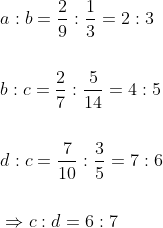
Thus,
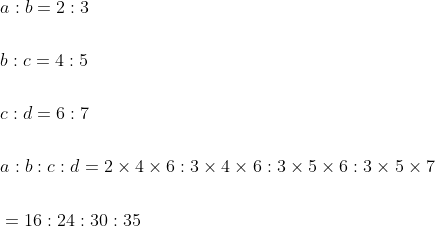
76 Ratio and Proportion - Trick #80
N/A


Example:


Solution:
By Applying Trick 80,
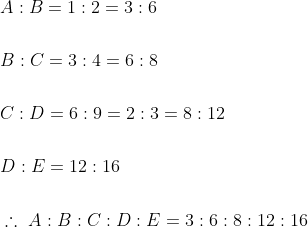
77 Ratio and Proportion - Trick #81
N/A
If an amount R is to be divided between A and B in the ratio m:n then
&space;Part&space;of&space;\(A=\frac{m}{m+n}&space;\times&space;R\))
&space;Part&space;of&space;\(B=\frac{n}{m+n}&space;\times&space;R\))
&space;Difference&space;of&space;part&space;of&space;}&space;A&space;\text&space;{&space;and&space;}&space;B=\frac{m&space;n}{m+n}&space;\times&space;R&space;\text&space;{,&space;})
where m > n
Example-1:
If an amount $250 is to be divided between P and Q in the ratio 3:2 then
how much will Q get on his part?
Solution:
By Applying Trick 81,

Therefore, Part of Q = 100
Example-2:
If $1000 is divided between A and B in the ratio 3 : 2, then A will receive?
Solution:
By Applying Trick 82,
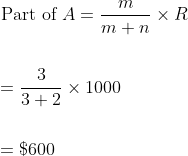
78 Ratio and Proportion - Trick #82
N/A
If the ratio of A and B is m:n and the difference in their share is ‘R’ units then,
&space;Part&space;of&space;\(A=\frac{m}{m-n}&space;\times&space;R\))
&space;Part&space;of&space;\(B&space;=\frac{&space;n&space;}{&space;m&space;-&space;n&space;}&space;\times&space;R\))
&space;The&space;sum&space;of&space;parts&space;of&space;\(A\)&space;and&space;\(B=\frac{m+n}{m-n}&space;\times&space;R\))
where m > n
Example:
If the ratio of A and B is 5:2 and the difference in their share is $75
then how much will A get?
Solution:
By Applying Trick 82,

Here, m:n = 5:2 and R = 75,
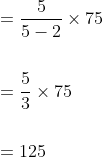
79 Ratio and Proportion - Trick #83
N/A
If the ratio of A and B is m:n and the part of A is ‘R’, then
\&space;Share&space;of&space;\(B=\frac{n}{m}&space;\times&space;R\))
\&space;Total&space;share&space;of&space;\(A\)&space;and&space;\(B=\frac{m+n}{m}&space;\times&space;R\))
&space;Difference&space;in&space;share&space;of&space;}&space;A&space;\text&space;{&space;and&space;}&space;B=\frac{m-n}{m}&space;\times&space;R)
where m > n
Example:
Marks of two candidates P and Q are in the ratio of 2 : 5. If the marks of P is
120, marks of Q will be?
Solution:
By Applying Trick 83,
&space;\\&space;\\&space;&=\frac{5}{2}&space;\times&space;120&space;\\&space;\\&space;&=300&space;\end{aligned})
80 Ratio and Proportion - Trick #84
N/A

\&space;The&space;share&space;of&space;\(A&space;=\frac{l}{l+&space;m&space;+&space;n&space;}&space;\times&space;R\))
\&space;The&space;share&space;of&space;\(B=\frac{m}{l+m+n}&space;\times&space;R\))
\&space;The&space;share&space;of&space;\(C=\frac{n}{l+m+n}&space;\times&space;R\))
\&space;Difference&space;in&space;share&space;of&space;\(A\)&space;and&space;\(B=\frac{l-m}{l+m+n}&space;\times&space;R\),)

\&space;Difference&space;in&space;share&space;of&space;}&space;B&space;\text&space;{&space;and&space;}&space;C=\frac{l-n}{l+m+n}&space;\times&space;R)
where m>n
Example:

Solution:
By Applying Trick 84,

&space;})

81 Ratio and Proportion - Trick #85
N/A

\&space;Part&space;of&space;\(B=\frac{m}{l}&space;\times&space;R\))
\&space;Part&space;of&space;\(C=\frac{n}{l}&space;\times&space;R\))
\&space;Difference&space;in&space;parts&space;of&space;\(B\)&space;and&space;\(C=\frac{m-n}{l}&space;\times&space;R\))
\&space;where&space;\(m>n)\))
\&space;Total&space;share&space;of&space;\(A&space;,&space;B\)&space;and&space;\(C&space;=\frac{(l+&space;m&space;+&space;n&space;)}{l}&space;\times&space;R\))


